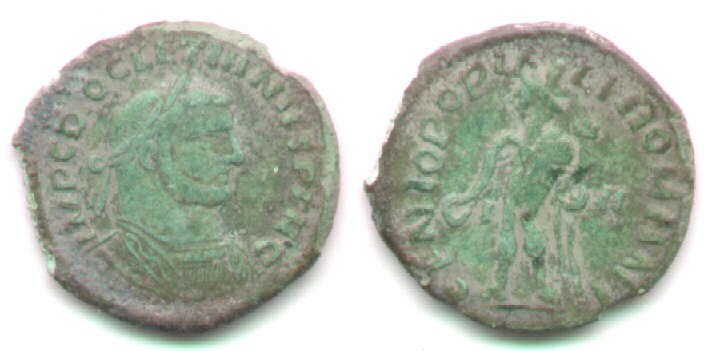

Imitations from the tetrarchy
Struck imitations of folles and reduced folles are uncommon to very rare until coins of types of Constantine began to be imitated in (and north of?) the Balkans.
Diocletian (284-305)


Follis imitation from Britain of the very common GENIO POPVLI ROMANI type. Also, its prototype
GENIO POPVLI ROMANI prototyle from the London mint
IMP C DIOCLETAINVS PF AC [blundered only at the very end -- the prototype ends AVG]
nothing in exergue, which indicates the London mint
AE26. 6:00. Minor edge chip at 9:00 from corroded flan. 4.87 grams (only about half the usual weight).
The imitation resembles RIC VI (London) 6a. Note that number 11 has legend ending "AV" and has "lettering crude, possibly semi-barbarous."
The illustrated similar coin is RIC VI (London) 6a "c. 300+".
Molds for imitating the follis (nummis) are "common" from Egypt. They have been found in excavations (90 percent of them are broken) in large numbers, but are rarely on the market. Imitation coins from those molds are very rare. Apparently a mold might make a coin, or even several coins one after another, but compared to the vast output of official coins struck from a single die, even the thousands of mold fragments found in Egypt have left very few coins.
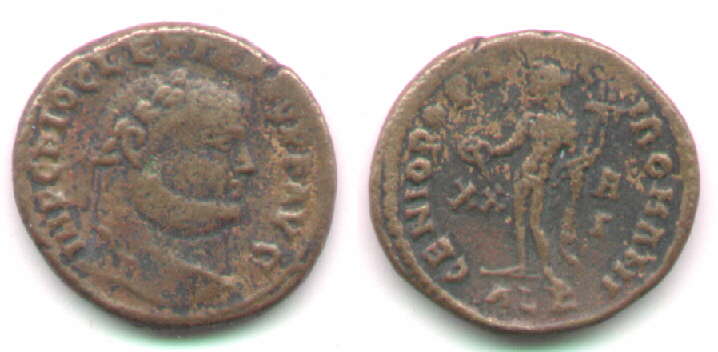
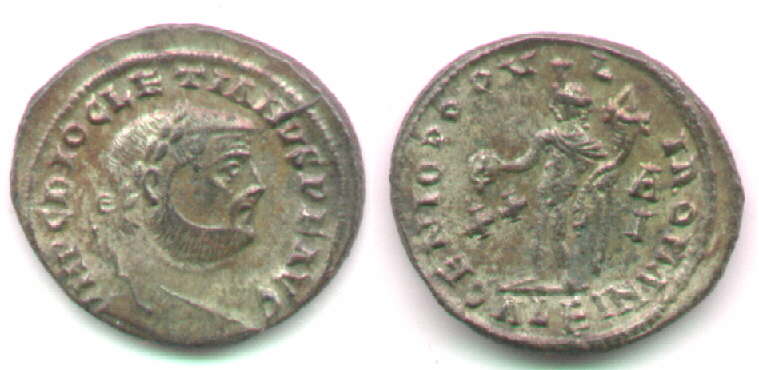
Cast follis imitation, GENIO POPVLI ROMANI, from Roman Egypt. Also, its prototype
AE25. 12:00. 9.42 grams.
IMP C DIOCLETAINVS PF AVG
/GENIO POPVLI ROMANI
XX in field left, A over I in field right
ALE in exergue.
RIC VI Alexandria 32a, page 665, plate 16, protype struck "c. 301"
Prototype: similar type.
AE28-26. 12:00. 11.04 grams.
RIC Alexandria 32a, page 665, plate 16.
The introduction of the new silver "argenteus" was accompanied by imitations (of course), but they are rare. Here is one:
Maximian (286-305)
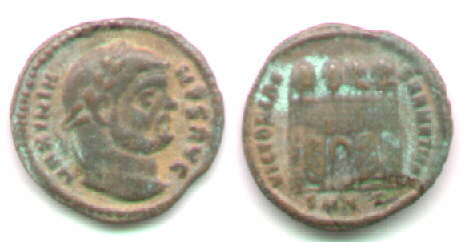
Cast argenteus core/VICTORIAE SARMATICAE
Cast AE imitation of a silver argenteus. Clearly cast. High relief, but blurry details.
AE16. 6:30. 1.99 grams.
MAXIMIANVS AVG
/VICTORIAE SARMATICAE, Camp gate with four turrets
SMN[gamma] in exergue
Prototype: RIC Nicomedia 22b, page 555, "c. 295." Type of Sear 3605.
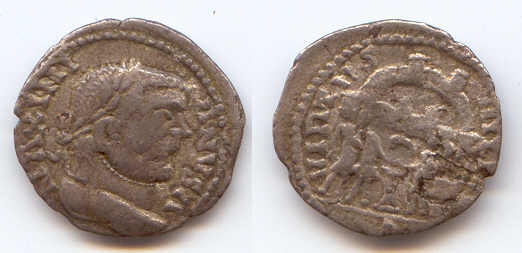 18 mm. 12:00. 1.79 grams. (Very light weight. Most are 2.75-3.75 grams)
18 mm. 12:00. 1.79 grams. (Very light weight. Most are 2.75-3.75 grams)
Imitation argenteus. Very crude engraving. Seems to be fairly good silver. Inspection under 20x of all the creades and corrosion shows nothing but silver.
MAXIMI - ANVS A (Legend does not finish AVG as it should. The A's are without crossbars), laureate head right
/VIRTVS - MILI[TVM] four emperors sacrifice over a tripod before the walled city with watchtowers.
Possiblly a letter for a mintmark, gamma?
Reference: Sisak hoard, plate 9.2 for possible prototype, Rome mint, second issue, with offician A-Z (in Greek).
RIC Rome 40b, AD 295-7 come with officina A-Z in the exergue.
For an aureus imitation of Maximian, jump ahead to the page on precious metals.
Maxentius (306-312)
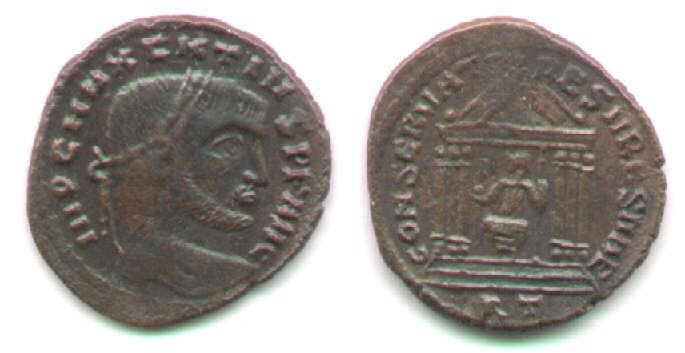

/CONVERVATORES VRBS SVAE, Roma seated in six-column temple. Also, a similar official coin.
IMP C MAXENTIVS PF AVG
/CONVERVATORES VRBS SVAE, Roma seated in six-column temple
Legible imitation. AE24. 6:00. 6.34 grams.
Minmark RT, imitating RIC Rome 162 (which is only listed as officina P) "c. Summer 307"
The similar type illustrated below is RIC Ticinum 91, with reverse legend CONSERV instead of CONSERVATORES, "Autumn 307 - Spring 308."
Imitations of Maxentius are very rare.
Licinius (308-324)
Licinius, remarkable bold obverse portrait and legend:
IMP C VAL LICIN LINCINIVS PF AVG an official legend at Rome, Heraclea, Nicomedia, and Cyzicus, spelled correctly, with somewhat irregular lettering.
/type of IOVI CONSERVATORI, Jupiter with Victory and sceptre, eagle at feet left, less well struck. Mint mark is obscure, seemingly with a "T" (?) at the right, which cannot be matched to a RIC prototype. However, this obverse legend matches this reverse type only at Heraclea, "c. 311".
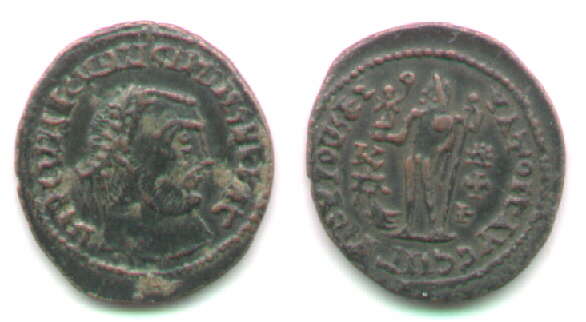

IOVI CONSERVATORI AVGG, Jupiter holding Victory. Also, its prototype.
AE23-20. 6:30. 3.23 grams
garbled obverse legend with letter-like forms, but not really letters
/excellent style imitation of Jupiter holding Victory with eagle with wreath in beak at feet left
K in field left, wreath/+/symbol in field right
mintmark garbled
Prototype here: AE21-20.12:00. 3.36 grams
IMP C VAL LICIN LICINIVS PF AVG, laureate head right
/IOVI CONSERVATORI AVGG, Jupiter holding Victory with eagle with wreath in beak at feet left
wreath/[delta]/N in field right
ALE (wreath) in exergue
RIC VII Alexandria 10<delta>, struck AD 315.
 Ugly gray base metal 22mm (distinctly larger than the prototype). 11:30. 3.43 grams
Ugly gray base metal 22mm (distinctly larger than the prototype). 11:30. 3.43 grams
/garbled IOVI CONSERVATORI AVGG type
Obverse legend crude and garbeled, with hints of letters in a typical Licinius legend.
K and eagle with wreath in beak in field left,
wreath/X/delta? in field right. Mint mark has, possibly, an "NVI"?
Prototype: RIC Alexandria 17 "AD 316-317". There are no similar minkmarks at Antioch, Cyzicus, Nicomedia, or Heraclea.
This coin is the plate coin in a section on ancient counterfeits in the book Classical Deception, by Wayne Sayles, page 27.
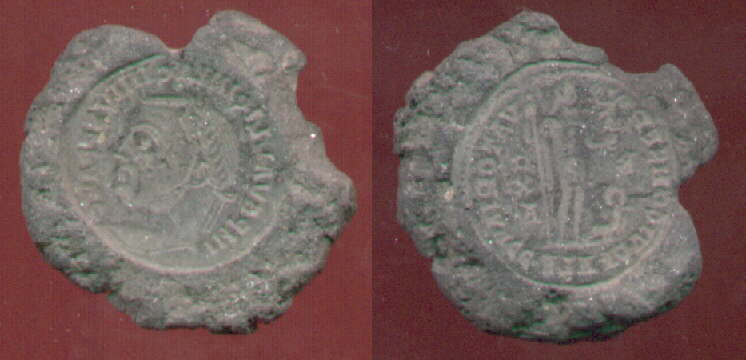 27 mm. Porous, light weight, clay.
27 mm. Porous, light weight, clay.
Mold: two sides (impressed from two different coins, possibly of the same type, as coins with this obverse and reverse do exist.)
Obverse of Licinius: IMP C VAL LICIN LICINIUS PF AVG (retrograde, of course)
/IOVI CONSERVATORI AVGG, Jupiter standing l holding Victory with wreath and sceptre
eagle at feet, K left, wreath above X above A right, ALE in exergue
Prototype: RIC VII Alexandria 18, AD 316-317.
Maximinus II (305-310-313)

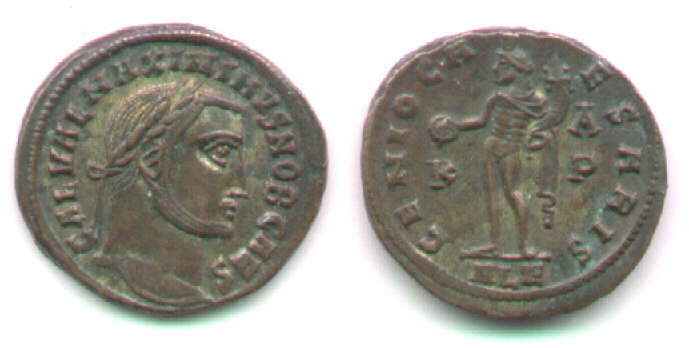
Maximinus II, cast copy from a mold like those below. Its prototype
Imitation: 23 mm. 11:00. 6.16 grams. Prototype: 25 mm. 12:00.
GAL VAL MAXIMINVS NOB CAES
/GENIO CAESARIS
/ALE in exergue, K left, B over P, right
Alexandria mintmark
Many molds for these casts have been found in Egypt. Ninety percent are broken. Coins from the casts are relatively rare.
References: Type of Sear 3763. RIC Alexandria 100aB, page 678 volume VI. Prototype struck "late 308-310."
Prototype: The same type, but officina A. RIC 100aA.
 33 mm. Coin diameter 22-23 mm.
33 mm. Coin diameter 22-23 mm.
Mold from Egypt used to cast imitation coins like those above. This is one mold from a gang of molds that would have been stacked together. Genuine coins were pressed into terra-cotta (a type of clay) which was then used to cast imitations. Different coins were used for each side of the mold. Of course, the impressions are mirror images of the orginal coins, so read the legends as mirror images beginning at 5:00 and going counterclockwise.
GAL VAL MAXIMINVS NOB CAES
laureate head right
This was the obverse of both coins impressed into the terra cotta of the mold. However, the styles of the heads are slightly different. The head on the right (convave side) is broader.
The next mold was bought with the above mold, but was probably not next to it in the stack of molds. (Here is a page about stacks of molds.) However, if it was a coin of the same type, and it seems likely it was, we can identify the original by its reverse type.
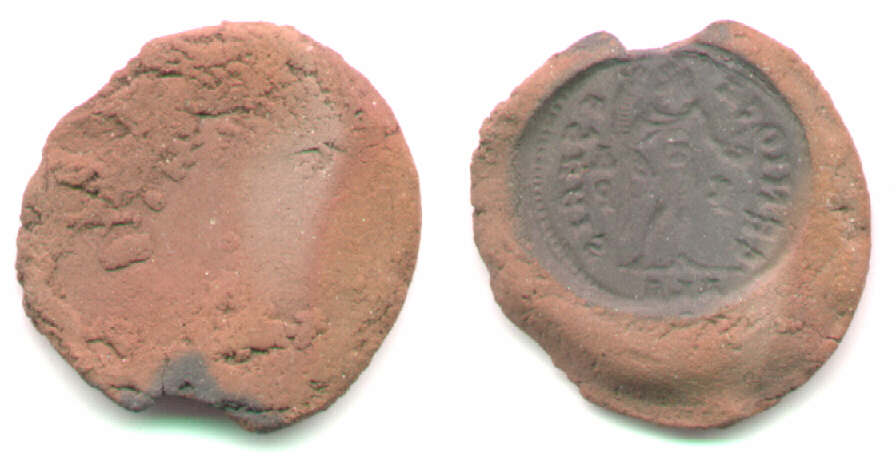 33 mm. Coin diameter 22-23 mm.
33 mm. Coin diameter 22-23 mm.
The end of a stack of molds. It has the impression of only one coin, a reverse, probably of a coin of Maximinus II like those above.
/GENIO CAESARIS, Genius standing holding patera and Victory crowning emperor
/ALE, K to left, A over P to right.
If the obverse was as above, the impressed coin was RIC VI, Alexandria 100aA, page 678, of late 308-310. This is the same type, with officina A instead of B, as the cast copy illustrated above.
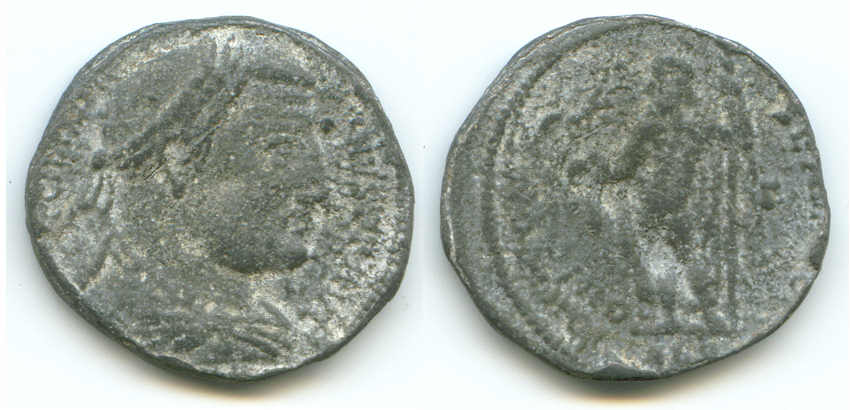 Lead, 24 mm. 11:30. 8.08 grams.
Lead, 24 mm. 11:30. 8.08 grams.
An ancient cast piece.
Very weak lettering, obverse ending NVS PF AVG
reverse IOVI CONS...
Jupiter standing left holding patera and sceptre
/ALE, gamma in field
The ticket said "ex Jungfleisch collection, circulated in south Egypt, extremely rare."
RIC VI, page 643, Ale 166b, says AD 311 for the prototype.
The prototype can be up to 25 mm but is supposed to weigh only 5.5-4.25 grams.
Go to the next page, imitations of coins of the British Empire (Carausius and Allectus). <
Return to the main Table of Contents page on imitations of Roman coins./big>